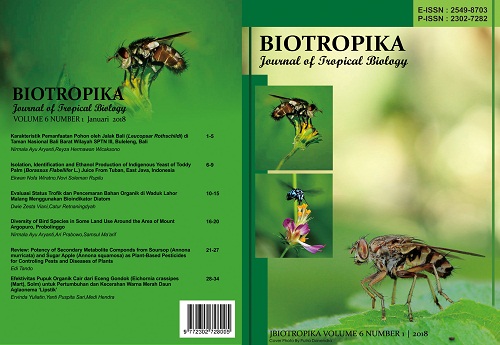Karakteristik Pemanfaatan Pohon oleh Jalak Bali (Leucopsar Rothschildi) di Taman Nasional Bali Barat Wilayah SPTN III, Buleleng, Bali
DOI:
https://doi.org/10.21776/ub.biotropika.2018.006.01.1Abstract
Leucopsar rothschildi (Jalak Bali) is an endemic bird species that only be found in the forests of the western of Bali Island. Wild catching and declining forest are the main factors of the declining population. The National Park of West Bali is the last bastion. The habit of living for activity and nesting in the trees make the importance of tree stand to be preserved. Therefore, this study was conducted to analyze the utilization's characteristics of trees by the birds in their original habitat in SPTN III West Bali National Park. The method used was concentration count to observe the characteristics utilization of trees and canopy. Behavior in their natural habitat was observed using Ad Libitum method. Data analysis was conducted by calculating percentage in each part of the usage of canopy and behavior type. The use of the canopy of trees in SPTN III of Labuhan Lalang TNBB by the birds for Tanjung Gelap was more frequent in the upper canopy (TA) section, in Labuhan Lalang more often in the middle canopy (TT) and the middle side canopy (TTt). Frequently activity in the canopy of SPTN III Labuhan Lalang by the birds was social activity.References
Halle, F. & R.A.A. Oldeman, 1975. An essay on the architechture and dynamics of growth of tropical trees. University Malaya. Kuala Lumpur. Malaysia
Firoroh, I., 2009. Kajian profil vegetasi terhadap konsevasi air (aliran batang, curahan hujan dan infiltrasi) di Kebun Campur Sumber Tirta Senjoyo Semarang. (Tesis). Sekolah Pasca Sarjana IPB, Bogor
Ginantra, I.K., A.A.G. Dalem, S.K. Sudirga & I.G.N.B. Wirayudha, 2009. Jenis-jenis tumbuhan sebagai sumber pakan Jalak Bali (Leucopsar rothschildi) di Desa Ped, Nusa Penida, Klungkung Bali. Jurnal Bumi Lestari. 9(1): 97-102
Mardiastuti, L.R. Salim & Y.A. Mulyani, 1999. Perilaku makan rangkong Sulawesi pada dua jenis Ficus di Suaka Margasatwa Lambusango, Buton. Media Konservasi. 6(1): 7-10
Surya, D.C., W. Novarini & A. Arbain, 2013. Jenis-jenis burung yang memanfaatkan Eurya acuminata DC di kampus Universitas Andalas Limau Manis, Padang. Jurnal Biologi Universitas Andalas. 2(2): 90-95
Wisnubudi, G. 2009. Penggunaan strata vegetasi oleh burung di kawasan wisata Taman Nasional Gunung Halimun – Salak. Vis Vitalis. 2(2): 41-49
Kurniasih, L. 1997. Jalak Bali (Leucopsar rotschildii Stresemann 1912) spesies yang makin langka di habitat aslinya. Makalah Ilmiah Biosfer. 9: 3-7.
Takandjandji M, Kayat & GND.Njurumana 2010. Perilaku burung bayan sumba (Eclectus roratus cornelia Bonaparte) di Penangkaran Hambala, SumbaTimur, Nusa Tenggara Timur. Jurnal Penelitian Hutan dan Konservasi Alam. 3(4): 357-369
Downloads
Published
Issue
Section
License
Copyright and Attribution:
Articles in Biotropika: Journal of Tropical Biology are under Creative Commons Attribution-NonCommercial (CC-BY-NC) copyright. The work has not been published before (except in the form of an abstract or part of a published lecture or thesis) and it is not under consideration for publication elsewhere. When the manuscript is accepted for publication in this journal, the authors agree to the automatic transfer of the copyright to the publisher.
![]() Journal of Biotropika: Journal of Tropical Biology is licensed under a Creative Commons Attribution-NonCommercial 4.0 International (CC BY-NC 4.0).
Journal of Biotropika: Journal of Tropical Biology is licensed under a Creative Commons Attribution-NonCommercial 4.0 International (CC BY-NC 4.0).
Permissions:
Authors wishing to include figures, tables, or text passages that have already been published elsewhere and by other authors are required to obtain permission from the copyright owner(s) for both the print and online format and to include evidence that such permission has been granted when submitting their papers. Any material received without such evidence will be assumed to originate from one of the authors.
Ethical matters:
Experiments with animals or involving human patients must have had prior approval from the appropriate ethics committee. A statement to this effect should be provided within the text at the appropriate place. Experiments involving plants or microorganisms taken from countries other than the author's own must have had the correct authorization for this exportation.

















